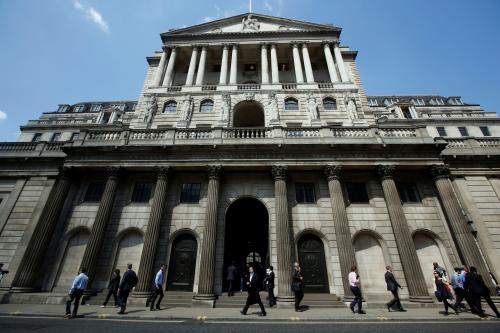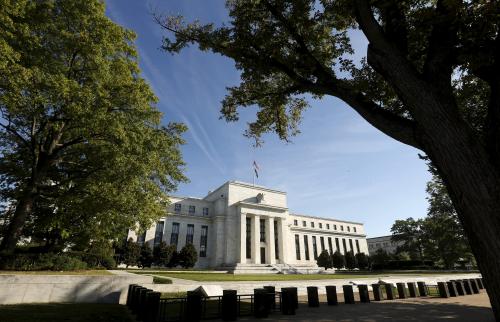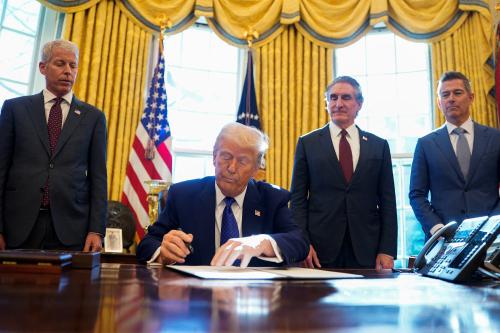Kohn delivered the following speech at the 200th Anniversary conference of the Danmarks NationalBank on September 7, 2018. The speech is also posted on the website of the Bank of England.
It is an honor to be participating in this celebration of the 200th anniversary of the Danmarks Nationalbank. The title of this session implicitly asks about the relationship of the good inflation and economic performance of the 1990s and early 2000s to the other key goal of central banks — financial stability, the distinct absence of which resulted in the Great Recession. Many lessons have been learned from the global financial crisis and slow recovery — including lessons for crisis management and for monetary policy at the effective lower bound for interest rates. But in my short time, I am going to reflect on the buildup of vulnerabilities during the good economic times and how to protect against that in the future. I fear memories may be fading; banks in the United States are profitable and well capitalized, and their requests for regulatory relief are falling on sympathetic ears in some quarters. Regulations can undoubtedly be made more efficient and effective, but now would seem a propitious time to review the lessons of the years before the crisis so as to avoid the trap of forgetting and repeating history.
Lesson 1:
Hyman Minsky was right: long periods of prosperity contain the seeds of their own destruction, operating through the financial system.
Many types of financial vulnerabilities have been identified as the proximate “causes” of the global financial crisis (GFC) — increases in leverage, greater maturity mismatches, migration away from banks to lightly regulated “shadow banks”, opaque and mispriced derivatives. But the underlying cause was complacency mixed with hubris. That mindset led the private sector to take what turned out in hindsight to be misunderstood and inadequately compensated risks, and it led regulators to be far too relaxed about what was happening.
The complacency was an understandable response to a long period of expansion with minor and infrequent recessions and low and stable inflation — the Great Moderation. The reasons for this good performance were many and some are permanent. Financial innovations allowed more sophisticated risk sharing and consumption smoothing; private nonfinancial businesses were tracking sales and managing inventories much better; central banks had improved policy frameworks to focus on price stability.
Surely the good times would last. Real estate prices could only rise; default probabilities could be forecast from recent benign history, so mortgage risk could be sliced and diced into tranches that would behave in a predictable way — a judgment validated by the credit rating agencies; compensation could be based on short-term profitability because the long-term held no special risks; euro zone countries would not default on their sovereign debt.
Complacency extended to the public sector watchdogs who were lulled by the reported rude health of financial institutions and came to believe that the private sector had the knowledge and incentives to police itself. In those circumstances, light-touch, principles-based regulation would facilitate private sector innovation and be sufficient to limit any macro risks.
We economists were complicit. We built models in which financial frictions played no serious role. The influence of financial variables on the economy could be summarized in a few interest rates and asset prices that were determined in efficient markets that incorporated all available information.
Sadly, we had to relearn what Minsky had taught us many years ago.
Negative developments for finance and spillovers to the economy are much more likely when tail risk…materializes in the context of easy credit conditions and extended balance sheets following a period of rapid credit growth.
Finance matters. When vulnerabilities mount in financial structures — what Minsky called speculative and Ponzi finance — cycles can turn quickly and downturns build on themselves.1 Negative developments for finance and spillovers to the economy are much more likely when tail risk—the unanticipated drop in real estate prices, the threatened default on the debt of a Eurozone government — materializes in the context of easy credit conditions and extended balance sheets following a period of rapid credit growth. In those circumstances, seemingly small shocks can result in very adverse feedback loops between finance and the real economy. Fear and uncertainty about the scale and incidence of the loses undermine access to funding, forcing fire sales of assets by lenders and sharp reductions in credit availability.2
These financial developments can have substantial externalities — collateral damage to households and businesses, most of whom are innocent bystanders in the preceding financial exuberance. Private sector participants in financial markets will not price these externalities.
Notably, in this story, the culprit is regulatory and private market failure, not too-easy monetary policy. In the US we experienced a small over shoot of our inflation target in 2006/07. Policy perhaps could have been a little tighter and less predictable, but the main problem in my view was the private and public decision-making that resulted in a Minsky cycle.
Lesson 2:
John Donne also was right: “No man is an island.” In a globalized financial system, developments readily cross national lines. What happens in the US, Eurozone, or Chinese financial markets will have effects far beyond the borders of the nation or the currency area.
One example is the global saving-investment imbalances that contributed to the buildup of risks. The other side of large current account surpluses and rising levels of reserves in China and other Asian countries in the first part of the 2000s was increasing debt and current account deficits in the US and elsewhere. And extra global saving put downward pressures on interest rates that encouraged leverage and rising asset prices.3
Moreover, the risk of the subprime mortgage loans originated in the US, partly in response to these incentives, was widely shared as was the risk of default by euro area governments. When those risks crystallized, when instability emerged, the effects also were shared globally — often through interconnections and interdependencies that were opaque or even invisible beforehand.
The sharp reduction in credit availability as lenders rushed to save themselves spread the cut back in spending around the world.
But when it came to responding to instability and protecting from the consequences, countries generally acted in their own self-interest. They took account of potential adverse spillovers on other countries largely because they saw those spillovers as affecting their ability to achieve domestic objectives.
Lesson 3:
Still, the Great Moderation and globalization had important benefits.
Compared to an environment of frequent recessions and variable inflation, steady growth and low predictable inflation, by reducing macroeconomic uncertainty, help households better plan their lifetime consumption and saving and judge the risks they can take. Businesses can invest and plan for medium and longer-term with more confidence. The implication of market price signals for shifts in supply and demand can be more easily interpreted. Predictable and more stable economies should foster better allocation of capital and faster productivity growth.
Greater openness in global product and financial markets, in turn, has lifted millions out of poverty and has promoted more efficient resource allocation and faster growth.
We need to find ways to save the gains while reducing the costs — protecting against the downside consequences of increasing complacency in growing economies in a globalized financial system.
Lesson 4:
Macroprudential policy is a promising addition to the regulatory toolkit that should help to mitigate the risks of Minsky-type financial cycles, enabling us to retain the benefits of monetary policy focused on sustaining the price and economic stability experience of the Great Moderation.
Good microprudential policy — institution-by-institution oversight — is the basic building block of financial system safety and soundness. Supervisors can assess the risk-management capabilities of an institution as well as the adequacy of its capital, liquidity and earnings prospects relative to its particular risks.
[W]e also need macroprudential policy… to make sure that enough resilience is built in to compensate for effects and externalities that are not apparent on an institution by institution basis.
But microprudential policy is not a sufficient tool for preventing the speculative and Ponzi finance Minsky warned us about and sustaining financial stability. For that we also need macroprudential policy — a policy that looks at the whole financial system with its interconnections, correlated positions, and vulnerabilities to economy wide and system wide tail risks — to make sure that enough resilience is built in to compensate for effects and externalities that are not apparent on an institution by institution basis. Macroprudential policy tries to assure that the financial system itself does not amplify shocks and will continue to deliver its essential services, even after severe, unexpected developments.
Some of those systemic externalities arise from structural factors — for example, institutions supplying very large amounts of services that can’t readily be replicated in failure, or market utilities that facilitate flows among many institutions, such as central clearing. These institutions must be held to higher standards for capital, liquidity and risk management, commensurate with the greater potential spillover from their failure. In the US, Dodd-Frank was very much focused on strengthening these SIFIs to make the financial system more resilient and less likely to need taxpayer assistance to safeguard the access to financial services for households and businesses.
But the lesson of the Great Moderation is that countercyclical macroprudential policy is also required to damp the potentially destabilizing increases in vulnerability that build during good times. Capital in financial institutions should be required to increase in those good times as risks of complacency and stretched financial positions rise. That capital might not do much to damp the asset cycles themselves, but it will help to mitigate risks from the natural human tendency to project that recent good times will continue, constraining the speculative and Ponzi finance on the upside so that institutions and markets can continue to lend and offer opportunities to manage risks when asset cycles turn down. At that point, the extra capital can be released to support lending.
This, of course, describes the countercyclical capital buffer (CCyB) of Basel 3. And increases in this buffer have come to be used in a number of jurisdictions as economies and banking systems have recovered from the GFC, including in the UK where I serve on the Financial Policy Committee that sets the CCyB.
Setting this requirement does have its challenges, including identifying and scaling vulnerabilities in environments in which, as is often the case, indicators are giving mixed signals, and then calibrating the appropriate CCyB setting. A second challenge to macroprudential policy more generally is identifying and dealing with financial vulnerabilities outside the banking system where they could be lodged in lightly regulated entities and markets. And a third is avoiding arbitrage across geographical jurisdictions that simply pushes risk around globally integrated financial markets. We have made progress on all three of these fronts since the GFC, but more remains to be done.
Despite these challenges, global financial stability would be better assured, in my view, if more jurisdictions, including the US, adopted more active use of the CCyB — made sure that banks and other intermediaries retained enough capital in the upswing now going on to safeguard their ability to deliver essential services at reasonable prices in the next downswing.
Stress tests are a critical building block for gauging the appropriate level of countercyclical capital. To construct stress scenarios, policy makers must assess the risk environment and build explicitly countercyclical explorations of tail risks — embodying larger falls as incomes and asset prices reach higher levels. Transparent and credible results are essential to maintaining public confidence and bank access to funding when buffers are released.
Stress tests should be a key input into a decision about the CCyB, but they are not a substitute for explicitly setting countercyclical capital buffers. The CCyB is a highly visible measure of the assessment of the authorities about the system-wide risk environment; in many jurisdictions it applies more widely than just to the subjects of the stress tests; and it can be increased or decreased on short notice when the risk environment changes rapidly and unexpectedly.
However, the CCyB alone will not be the most efficient or even a sufficient way to mitigate many financial stability risks. For example, mortgage lending against residential real estate has been the culprit in quite a few financial sector problems in many jurisdictions. And the externality from troubled housing markets can come from the cutbacks in spending by borrowers who are struggling to service their debt as well as from lenders. The ability to set minimum standards for mortgage lending should be in the tool kit of every macroprudential authority and that authority should be willing to use it countercyclicly. Here again, I’m afraid that the US falls short of even having the typical macroprudential tools, much less of an intention to use what controls there are to foster financial stability.
Active use of macroprudential policies should enable monetary policy to remain focused on price and economic stability in the medium run. Under most circumstances, macroprudential tools of the sort we have been discussing are likely to be far more effective dealing with financial stability risks than would be the interest rate tools of monetary policy, whose comparative advantage is countering real and price shocks. With two goals—price and financial stability—and two sets of tools, we should be able to come close to having our cake and eating it too — sustained expansion at low stable inflation rates uninterrupted by periodic financial crises.4
Lesson 5:
Public understanding and support is critical to sustaining effective policy—and that includes countercyclical macroprudential policy.
Public distrust of technocrats has greatly increased since the GFC. Many factors have contributed to that, but a sense that the crisis response favored the financial sector over the general public has surely played a role. We didn’t do as well as we needed to connecting the actions to stabilize the financial system and encourage the recovery to the welfare of individual households and businesses.
Tightening regulation in good times when the financial system is perceived to be strong, and easing requirements when developments threaten to weaken it, will not be intuitive to many people. Banking lobbies will be opposed to increases in capital requirements or greater restrictions on loan terms, and they will try to rally the public to their perspective by citing increased costs of credit. People worried about protecting taxpayers and deposit insurance funds will be hesitant to buy into any relaxation when the cycle turns.
We need to be active now in explaining to the general public as well as to their elected representatives the public benefits of countercyclical macroprudential policy and reminding them of the lessons learned about increasing complacency in good times leading to the kinds of serious economic deprivations we experienced not so many years ago.
-
Footnotes
- See https://www.economist.com/economics-brief/2016/07/30/minskys-moment for a nice summary of Minsky’s thought.
- This is similar to the message of recent work at the IMF on GDP at risk: Looser financial conditions can raise growth in the near term but also increase the likelihood of a significant slowdown or even recession in the medium-term, a tradeoff that is amplified when there has been a credit boom. https://www.imf.org/en/Publications/WP/Issues/2018/08/02/The-Term-Structure-of-Growth-at-Risk-46150
- Some of these thoughts were developed by Ben Bernanke in: https://www.federalreserve.gov/boarddocs/speeches/2005/200503102/.
- See Kohn https://www.bankofengland.co.uk/speech/2017/cooperation-and-coordination-across-policy-domains for a discussion of macroprudential and monetary policy tools.
The Brookings Institution is committed to quality, independence, and impact.
We are supported by a diverse array of funders. In line with our values and policies, each Brookings publication represents the sole views of its author(s).






